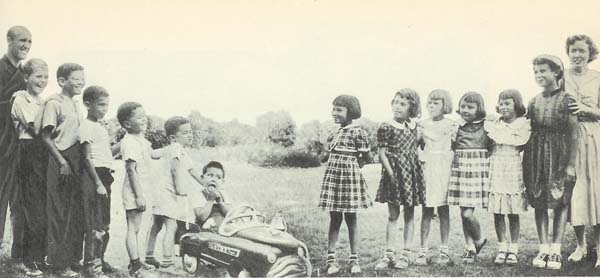| The one question
that always brings me up with a start is, “What is it like,
having a family that is a miniature United Nations?”
From our point of view our family is no different
from the average family, except that we probably have more fun because
there are so many of us. We’ve enough right here in the house
to play London Bridge on a rainy day. Meals are always a party.
Even bedtime isn’t so bad when a whole gang goes with you.
I think that perhaps the nicest part of all is
the thrill of watching so many budding personalities unfold, each
with such individual, fascinating possibilities.
The fact that none of my children was actually
born to me rarely enters my consciousness. After all, even a biologic
newborn is not always what his parents expected or hoped for, and
all parents who honestly want their children love each little newcomer
for what he is. In the long run it doesn’t seem to make any
appreciable difference whether the baby arrives via the stork or
a social worker. Indeed, when parents approach adoption not solely
on the basis of their own wishes but also to meet the needs of a
rejected child, the groundwork is laid for ties of love that can
be, and often are, far stronger than in biologic families.
Friends well acquainted with our children never
ask, “How can you feel like a family with such foreign children?”
Instead they exclaim, “They seem so much like brothers and
sisters! It’s hard to realize they represent so many races
and nationalities.”
After a discussion I heard the other day in the
back yard, I decided that with our family almost anything
can happen.
I was hanging up clothes when Donny, from the
stump where he was preaching a vigorous sermon, suddenly announced,
“When I grow up, I’m going to be a minister like Daddy.”
Teddy, constructing an intricate steeple with
lumber ends, squatted back on his heels, his brown face serious.
“When I grow up,” he piped, “I’m going to
be a minister and build a new church.”
“I’m going to be a minister and have
babies,” Laurie chanted, as she pushed by with her doll buggy.
“Girls aren’t ministers,” Donny
decreed. “Would you like to marry a minister and
have little minister babies?”
“Okay,” Laurie agreed amiably.
“Me, too,” black-haired Rita chimed
in from over near the faucet where she and Susie were making mud
pies. Susie chattered something and I called out, “What did
you say,” Susie? You’re going to marry a minister too?”
“Three-year-old Susie looked at me, scorn
in her blue eyes. “Not me,” she stated emphatically.
“I’m going to marry a fire engine!”
If you could see our children working, playing,
sharing together, dark hair against fair, black eyes laughing into
blue, I’m sure you would feel as we do: when there is love
and understanding and a common level of culture, artificial barriers
of race or nationality disappear. Actually, we are more than an
“international family.” Our home, with its strong ties
of mutual understanding and love, is symbolic of that most inclusive
family of all, God’s family.

|



